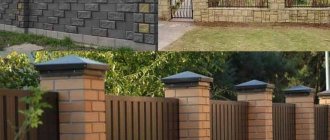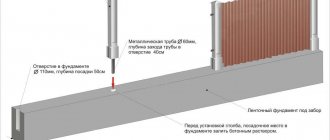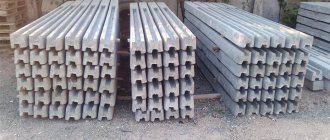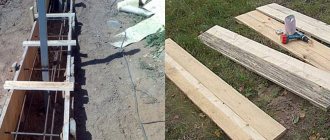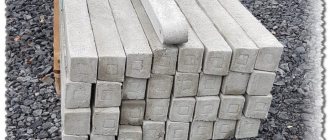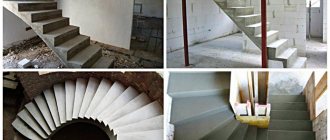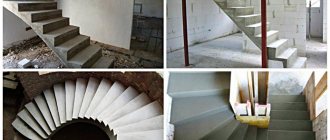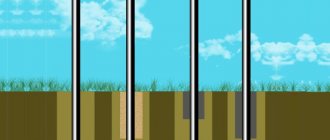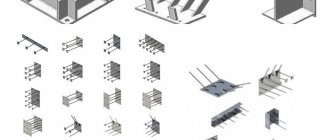Home |Construction |How to make concrete fence posts with your own hands?
Date: March 1, 2017
Comments: 1
Owners of summer cottages and private houses, ensuring the safety of their own territory, install enclosing structures - fences - around the perimeter. Their basis, along with metal, brick, asbestos-cement pipes and wood, are concrete posts for fastening fence sections. You can, of course, buy ready-made columns, but it is more profitable to make them yourself.
It’s easy to make concrete support posts for your fence with your own hands. This will save financial resources and create a reliable foundation for the fence that fully complies with the developer’s plans.
By making concrete fence posts yourself, you can individually determine the profile and dimensions of the products and install embedded elements in the required places, which is important when constructing non-standard fences.
The article provides information about the stages of making concrete pillars with your own hands, design features, and manufacturing technology.
Before you start making concrete pillars, you should definitely decide for yourself whether this particular type of support is right for you.
Types of technologies
To make concrete pillars with your own hands, the following production technologies are used:
- Manufacturing in reusable structures in a separate site with subsequent removal of supports after hardening and installation of it in the enclosing structure, according to the developed scheme.
- Filling with concrete mortar individual shapes of the required cross-section (round, square, rectangular, etc.), pre-installed at the installation site of the supports along the perimeter of the fence.
Main stages of manufacturing
Regardless of the specifics of the manufacturing technology, the set of measures according to which concrete pillars are made includes the following steps:
- assembly of formwork, the quality of which determines the presentation of the resulting products;
- production of a reinforcement frame that ensures the strength of the elements;
- preparation of a cement mixture, the strength of which after hardening determines the performance characteristics of the supports;
- filling with a solution, after hardening, ready-made fence posts can be removed.
It is worth remembering that the service life directly depends on the quality of the material used in the manufacture of supports
Alternative manufacturing methods allow you to pour a concrete pillar with your own hands directly on the site where it will be used in the enclosing structure. Let us dwell in detail on the features of the stages of work.
Advantages and disadvantages of concrete pillars
There are many options for installing a fence. You can use ordinary wooden poles, metal or brick supports. More interesting solutions are also used - for example, gabions. One way or another, the fence should organically fit into the design of the site and serve you for many years. Therefore, the more reliable the materials you select, the longer the fence will not require repairs.
Pros of concrete pillars
- Strength Concrete is one of the most durable materials in construction. It is not without reason that multi-storey buildings and complex engineering structures such as dams, bridges and so on are built from it.
- Ability to withstand heavy loads Concrete can maintain its structure under pressure of 400 kg per square centimeter. Of course, this applies to high-end brands that are not used in the average garden. But less durable concrete can easily withstand the weight of any fence fabric - be it chain-link mesh, polycarbonate, boards, corrugated sheets or other material.
- Wear resistance In principle, any materials sooner or later become unusable. The only question is how much time will pass before that. Take a look at the old Soviet concrete buildings? Yes, somewhere they have lost their aesthetics, but they still perform their functions. A properly made wooden fence will serve you for 20 years. Metal is more reliable, but it also has a weak point - it is susceptible to corrosion. For the first five years, metal supports will stand quietly in any climatic conditions. But then they will begin to “rot.” The rate of rusting can reach half a millimeter per year. That is, with a column thickness of 3 mm, corrosion will destroy it within 6-7 years. In this sense, concrete is much more reliable. It does not rust or rot, insect pests do not grow in it, it tolerates heat and cold well, and is not afraid of fire. In fact, if the concrete was prepared according to the correct recipe, its service life will be at least 50-70 years.
- Possibility of decorative design Concrete can be given almost any shape - round, square, with protrusions or recesses. In addition, finished poles can be further decorated by applying decorative plaster, epoxy, acrylic, rubber or polyurethane paint. If you are embarrassed by the look of bare concrete, you can cover it with decorative panels or line it with stone.
Cons of concrete pillars
Although there are not many disadvantages of concrete, they do exist.
- Heavy weight of structures. Concrete density reaches 2,500 kg/m3. One pillar will weigh from 80 to 100 kg or even more (this depends on the composition of the mixture). Working with concrete pillars alone is difficult.
- The importance of maintaining proportions When preparing the solution, it is very important to correctly measure all components. After all, if, for example, you overdo it with water, the pillar will turn out to be fragile. And if you pour too much cement, the mixture will not compact well and voids will remain inside. Later in the article we will present the proportions of concrete for fence posts. With their help, you can prepare a solution of the desired consistency.
- Long setting time Concrete gains strength in 28 days. Only after this is it able to withstand the design loads and not collapse. Of course, the pillars can be installed earlier (without installing a fence on them), but even here you will have to wait. The concrete will take 2-3 days to set, during which time it should not experience any stress.
Our own concrete production and laboratory, as well as a large fleet of equipment guarantee high quality products and accurate delivery times
Concrete - production and delivery
Concrete pumps - rent
Read more about us here
7 904 179–31–56
Valentin Yurievich Shvets
Director of BetonStroy
Manufacturing of formwork
High-quality formwork allows you to ensure the presentation of products and guarantee their strength characteristics, provided that the appropriate cement mortar is used and the correct reinforcement is used. When thinking about formwork for fences and posts, pay attention to the following points:
- The choice of material intended for assembling the form. The material can be metal, wood, plastic and specially impregnated thick cardboard. When deciding on the material, remember that the structure must remain strong when poured and not deform.
- Production of formwork corresponding to the dimensions of the products. The structure must be rigid. It is advisable to weld sheet metal, and connect wooden blanks with screws or self-tapping screws.
Concrete supports have only one drawback - the need to create a foundation for their installation, without which the fence can bend and collapse
The design features of the formwork should allow easy removal of the finished product. This is ensured by the trapezoidal cross-section of the structure, poured on a separate site and the use of planed boards. To make it easier to remove concrete fence posts, use plastic film placed before pouring the concrete mass.
Forms made of wood and metal can be used repeatedly, are quickly assembled and easily dismantled. They allow you to reproduce the required geometry of the supporting elements of the fence.
When making formwork designed to form permanently installed fence posts, pay attention to the strength of the section located at the bottom of the column and supporting the weight of the concrete mass.
Circular support elements, poured on site, can be formed in disposable cardboard forms, reinforced on the outside with a wooden frame or steel mesh for reinforcement.
The formwork, poured with concrete at the installation site, takes up increased loads in the lower part and is distinguished by a vertical position when pouring. A vertically located, unstable structure requires the installation of reliable supports. When ensuring that a vertically positioned structure is stationary, avoid bending it, as it is susceptible to bending loads.
Having made concrete fence posts with your own hands once, you can do it at any time as needed
Price
You can buy ready-made elements in construction stores, special open areas or through Internet sites. As a rule, the stands display product samples with different textures and color options. The products themselves, delivered to the customer, are packaged in film and placed on pallets.
Country house fence
Many retail outlets offer delivery to the installation site and recommend craftsmen to carry it out. The cost of individual collections of elements with covers is presented in the following list:
- “Stone” size 380x380x200 mm – 510 rubles; cover – 580 rub.
- “Britannia” size 380x380x200 mm – 510 rubles; cover – 480 rub.
- “Slate” size 330x330x200 mm – 610 rubles; cover – 480 rub.
- “Cobblestone” 330x190x190 mm – 305 rubles; cover – 305 rub.
- “Chopped brick” 330x190x190 mm – 510 rubles; cover – 380 rub.
Considering the considerable cost of the product, before you buy it, you should make sure that it is certified and has a guarantee. A careful external inspection will help identify defective specimens. If the shortcomings are systemic (chips, unclear texture), then it is better to contact another seller or manufacturer.
Reinforcement
Concrete columns for the enclosing structure will be strong if you take a responsible approach to the manufacture of the reinforcement frame. Concrete pillars absorb compressive loads and bending forces. That is why a frame made of steel reinforcement is needed.
Structurally, it represents a spatial system, the basis of which is the following elements:
- four longitudinally located rods with a diameter of 12-18 mm, corresponding to the length of the future post;
- transverse elements with a diameter of 8-10 mm, located at intervals of 100-150 mm, fixed to the longitudinal rods with binding wire or welding.
When installing the reinforcement cage, ensure a fixed distance of 2-2.5 cm from the steel bars to the walls. This will protect the reinforcement elements from the destructive effects of corrosion.
Creating forms yourself
However, a person himself is capable of making similar forms. To speed up the process, you will need a multi-position matrix. With its help, you can cast four pillars at a time.
The matrix will require boards with the following parameters:
- 3x 25 x 250 cm (9 pieces);
- 3x 25 x 100 cm (2 pieces).
You will also need the following from the list:
- wood screws,
- a tool for screwing them in (a screwdriver, but a screwdriver is better),
- metal plates (8 pieces),
- sheets of tin,
- used oil,
- concrete composition,
- fittings
The following is a diagram of such a matrix:
The action plan is:
- Six boards 250 cm long and three boards 100 cm long are covered with tin on one side. The three remaining boards are upholstered on both sides.
- The formwork is assembled using screws. Nails are not suitable here, because they are very difficult to remove.
- The matrix is treated with waste oil.
- The reinforcement is tied and laid.
- The concrete composition is poured. He meticulously equalizes the entire form.
- An equal distance is measured on both sides, and metal plates are installed. The frame will be attached to them.
- The matrix is covered with damp burlap. This mold must be wetted for seven days.
Preparation of concrete solution
Preparing concrete composition for pillars is a critical operation performed after installing the reinforcement cage. The quality of the mixture and increased strength characteristics of concrete products will be ensured by the following components:
- Portland cement grade M500.
- Pre-sifted river sand.
To make the pillars as strong as possible, use only high-quality cement
- Small crushed stone up to 10 mm in size.
- Water.
The optimal ratio of crushed stone, sand and cement is 2:2:1. When preparing concrete, mix the ingredients using a concrete mixer. This will ensure a uniform consistency of the mixture. Having prepared the solution, you can start pouring.
Filling with solution
Pouring concrete is the final stage of making pillars with your own hands. Complete the forms in the following sequence:
- Apply a lubricant to the inner surface, which allows you to later remove the finished product;
- place the reinforcement frame in the mold;
- fill the formwork with concrete solution;
- compact the mass by placing the filled formwork on a vibrating table. It is allowed, using reinforcement, to remove air inclusions and compact the form using a hammer drill;
- ensure that the concrete can be hydrated throughout the day;
- Carefully remove the post to dry.
The use of ready-made fence posts is possible after hardening for 2-3 weeks. Remember the need to daily moisten hardening concrete and install embedded parts before pouring the solution into the formwork. It is also necessary to clean reusable molds from any remaining mixture for reuse.
Types of typesetting blocks
According to the manufacturing method, fence blocks are:
- concrete;
- pressed.
Decorative pressed and concrete blocks
Concrete blocks are quite rare and are made by small entrepreneurs, but they do exist. More often you can find ready-made columns. The main manufacturing method is pressing.
It is quite easy to distinguish them by their surface structure. Concrete will be smooth, while pressed ones will have a slightly porous structure.
They also differ in appearance and can be:
- decorative;
- splitter (hollow).
They can be of various shapes and sizes and can be selected according to shape, color and size.
Depending on what filling they have, the texture changes:
- Gravel. Such blocks are perfectly fastened together.
- Granite screenings can give the finished product a dark red hue.
- Concrete scrap is distinguished by its affordable cost and minimal aesthetic characteristics.
- Crushed stone is used to make the surface of the product decorative.
- Expanded clay. Structures made from this building material are very light and beautiful.
Decorative fence blocks have a special shape and can be of different colors and textures. Natural stone pillars are especially popular today. The voids inside are filled with concrete.
Decorative stone pillars
Externally, it is no different from natural stone, but looks solid and attractive. In the manufacture of such forms, dry pressing technology is used. As a result, the product looks like split natural stone. Fence posts with imitation torn stone can have a one-sided or two-sided pattern.
Splitter products are hollow inside. Concrete is poured into the cavity and reinforcement is installed. Thanks to the large size of the blocks, equal to 7 bricks, such fences are quickly installed.
Not only pillars, but also the fence itself can be made into splitter elements.
Features of alternative manufacturing technology
In a number of situations, it is advisable to manufacture supporting elements for the enclosing structure at the installation sites along the perimeter of the future fence. For these purposes, builders use sliding formwork, the elements of which are parts of a steel pipe cut along the longitudinal axis, with a diameter of about 1 meter. The components of the form are equipped with brackets with holes that allow you to fix the structural elements. Carry out the process of pouring support elements for the fence with your own hands according to the following algorithm:
- Lubricate the surfaces of the sliding mold with a special emulsion.
- Connect the mold elements using fastening brackets.
- Install the formwork in a pre-prepared pit, controlling the verticality with a level.
- Place the reinforcement frame into the mold.
High-quality formwork is the key to creating smooth and strong concrete pillars - Fill the slipform with concrete mortar.
- Compact the mass using an in-depth concrete vibrator or vibratory pressing.
- Ensure that the form does not move for 2-3 days.
- Loosen the tightening bolts.
- Move the sliding form up 75% of its length, ensuring that the bottom portion is secured to the pre-cast concrete column.
- Repeat the operations until the vertical support is completely formed.
Developers also use PVC pipes of increased diameter and asbestos cement formwork as a form for the construction of support posts. The technology makes it possible to cast supports of round, square, rectangular and rhombic cross-sections.
Supports for various fences
Having decided to independently fence the territory of your house, cottage, or other area, you have to choose the support material for installing the fence. For this, different building materials are used - metal and asbestos-cement pipes, wood, brick, which, unfortunately, is expensive. The most advantageous material in terms of price and durability is the option with concrete pillars, to create which you will need forms for pillars, made or purchased. Sometimes it is possible to rent formwork.
Mold for casting a column segment
The price of modern concrete mixtures has also increased, because various additives are added to them to improve quality, moisture resistance and appearance. But still, concrete products are much more cost effective than other materials.
